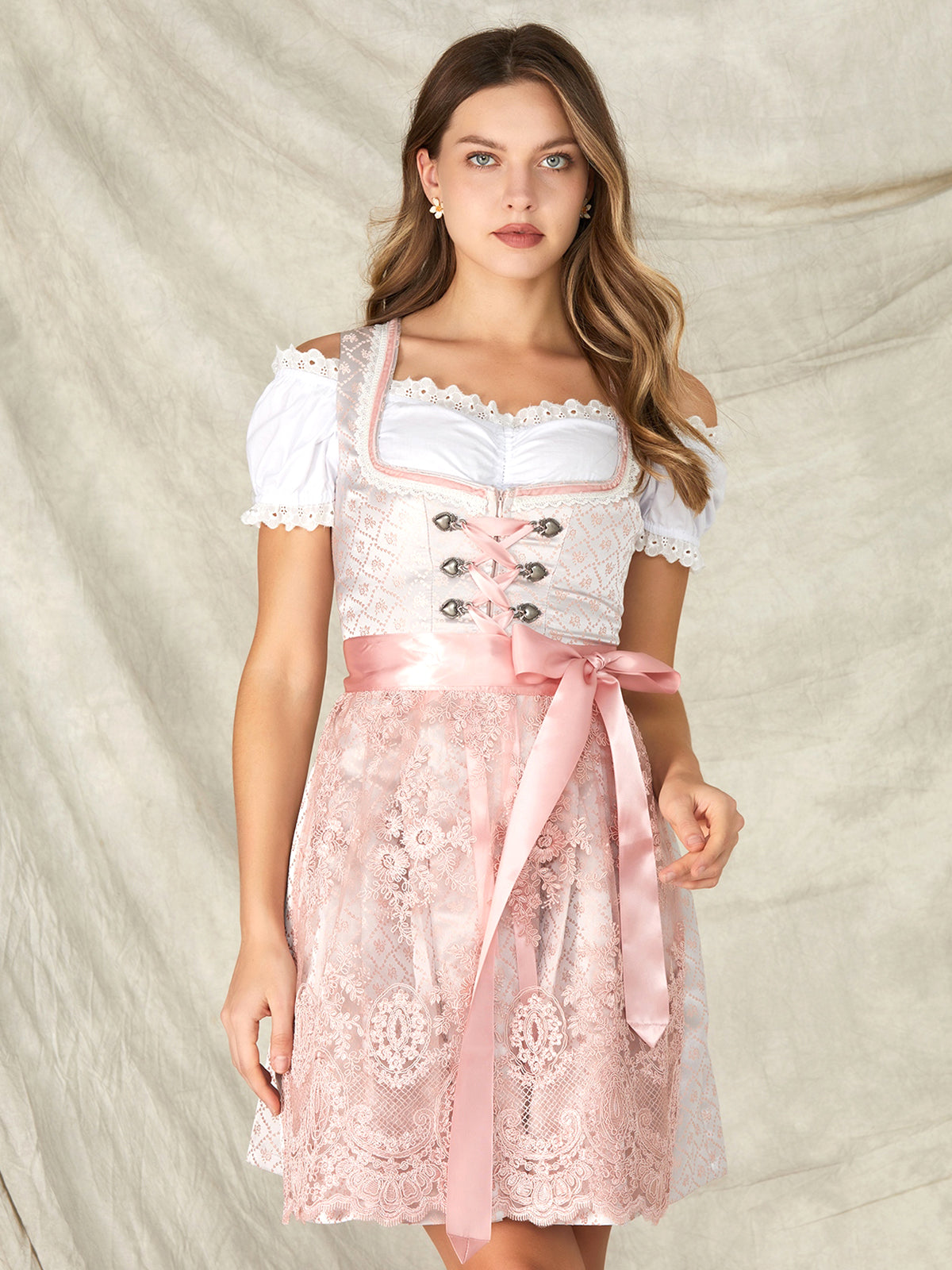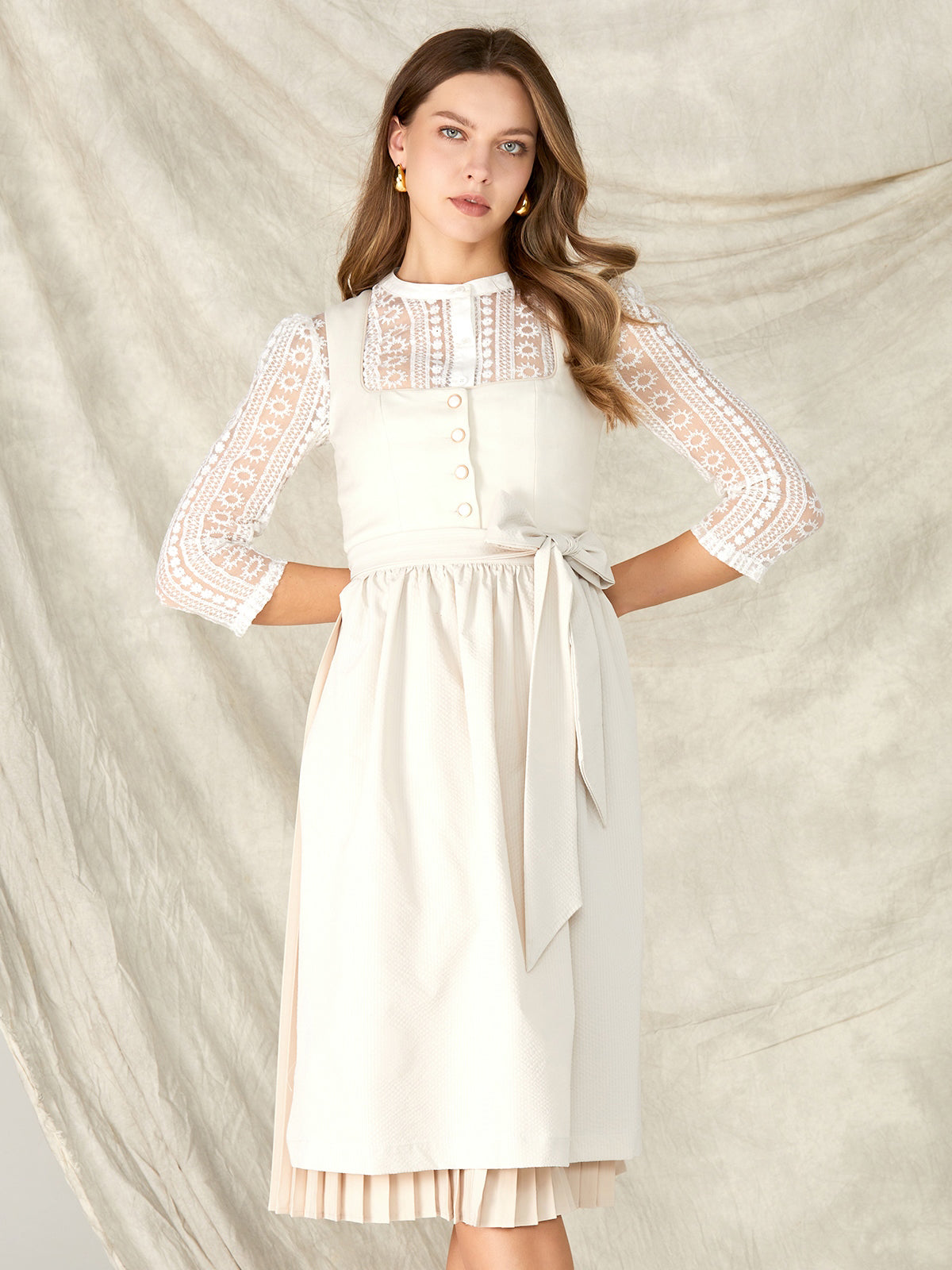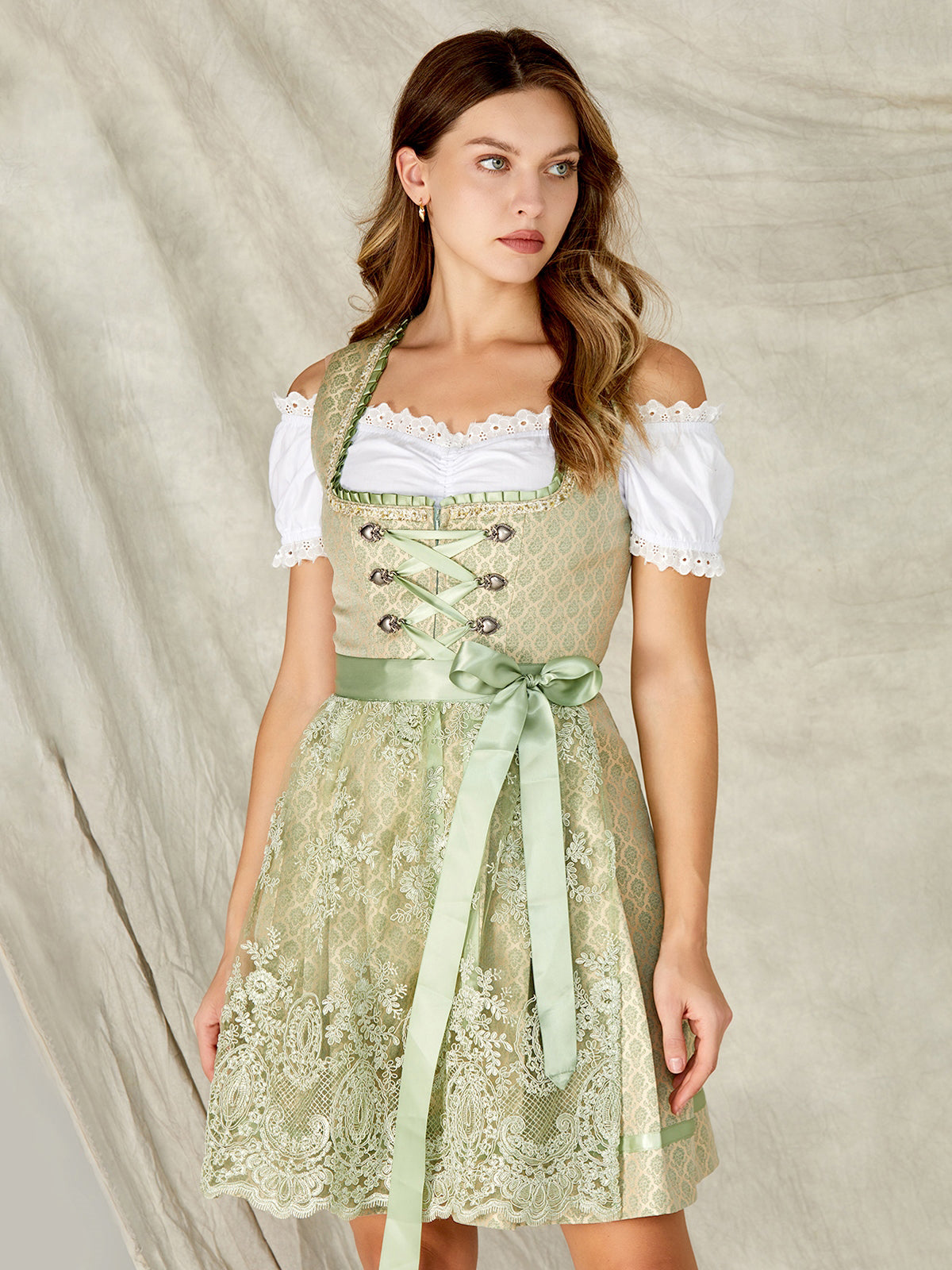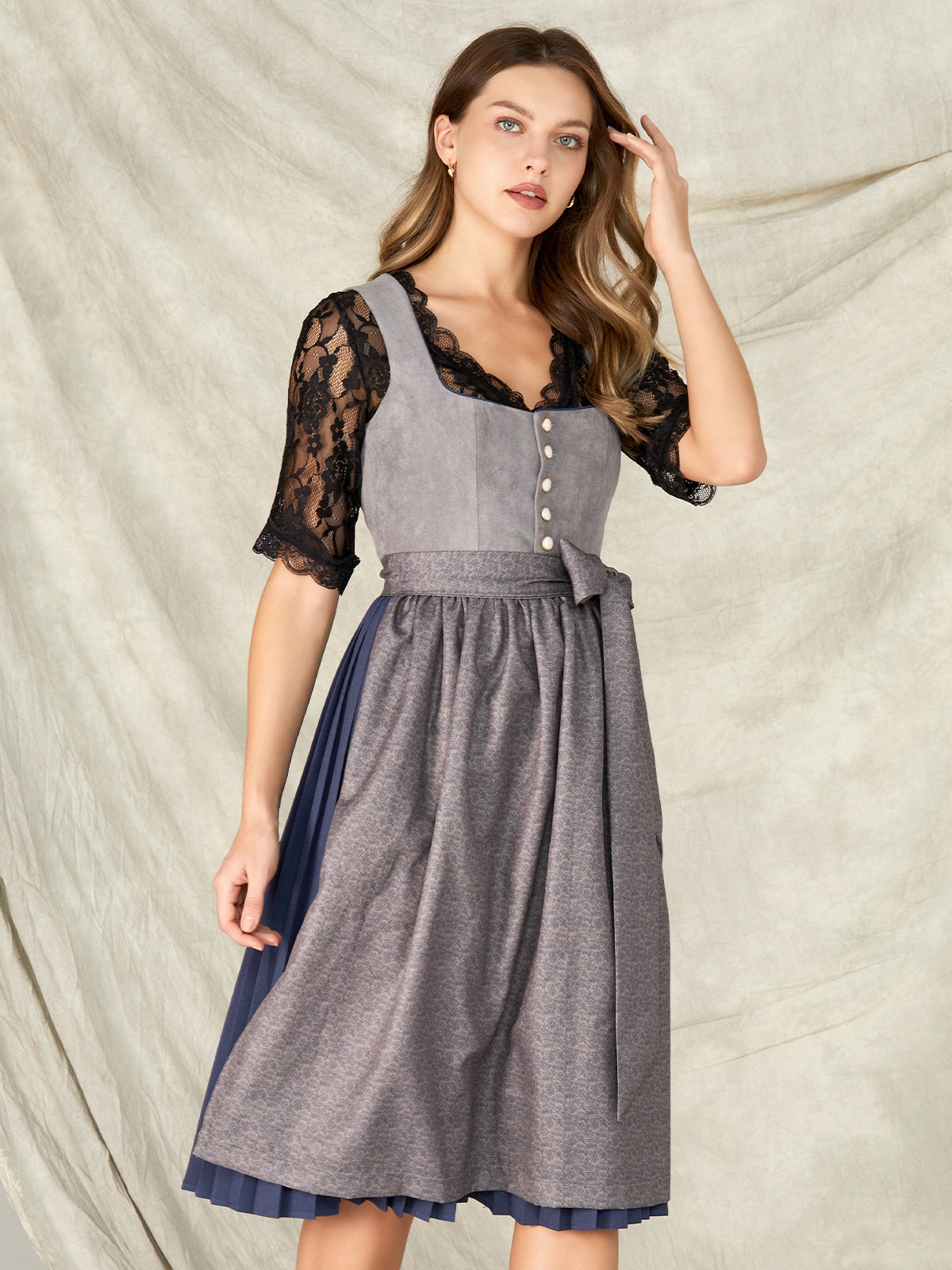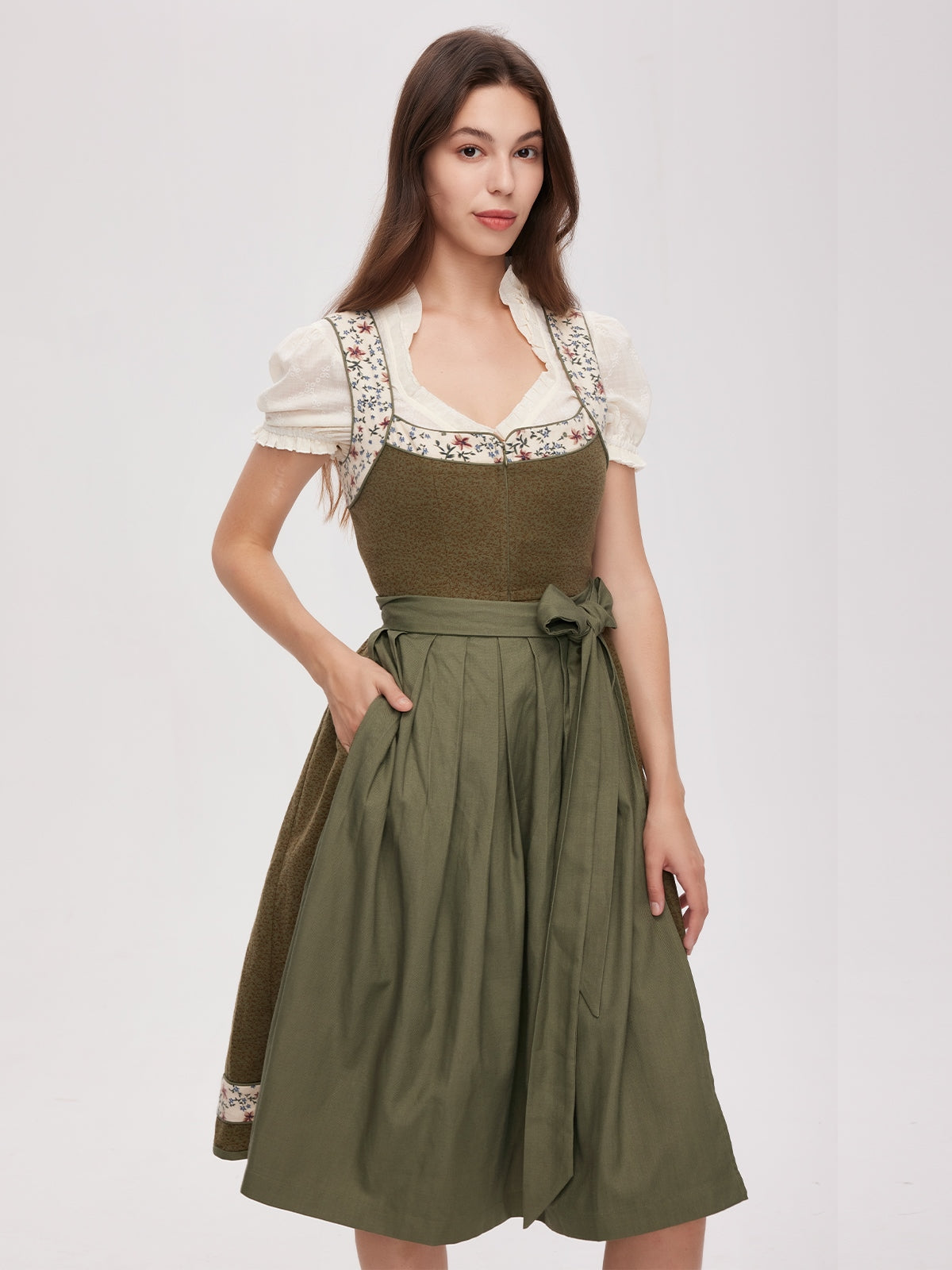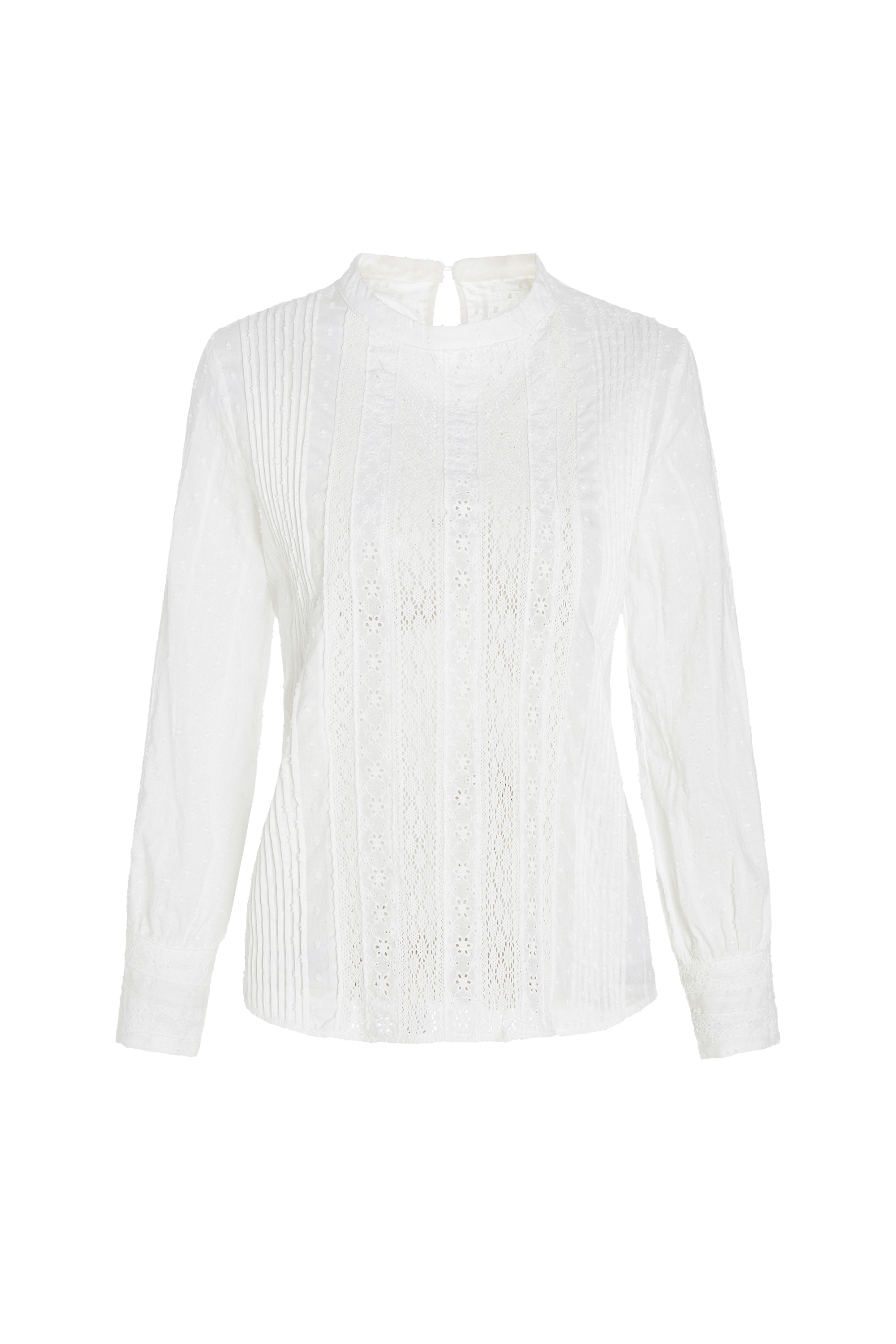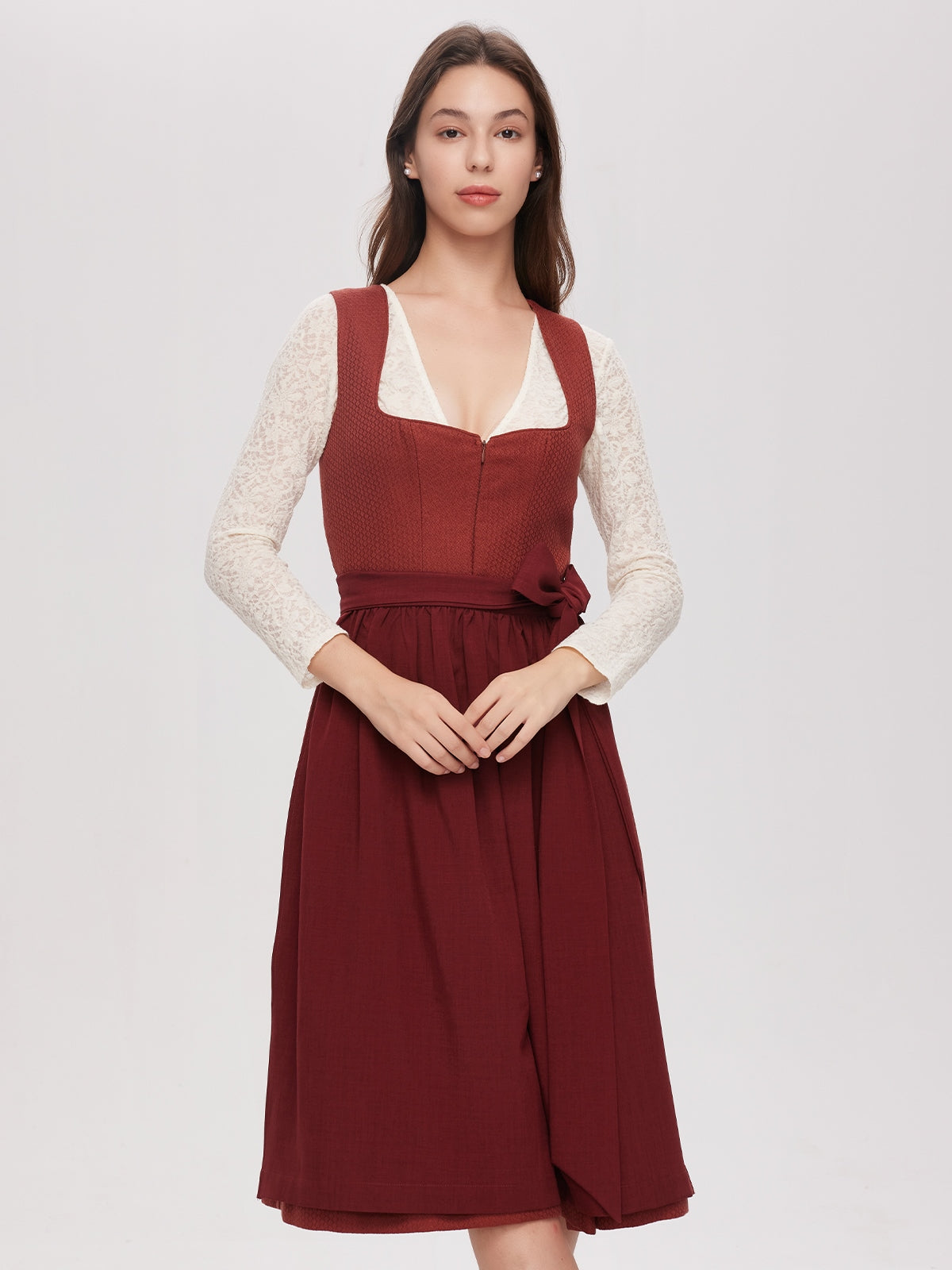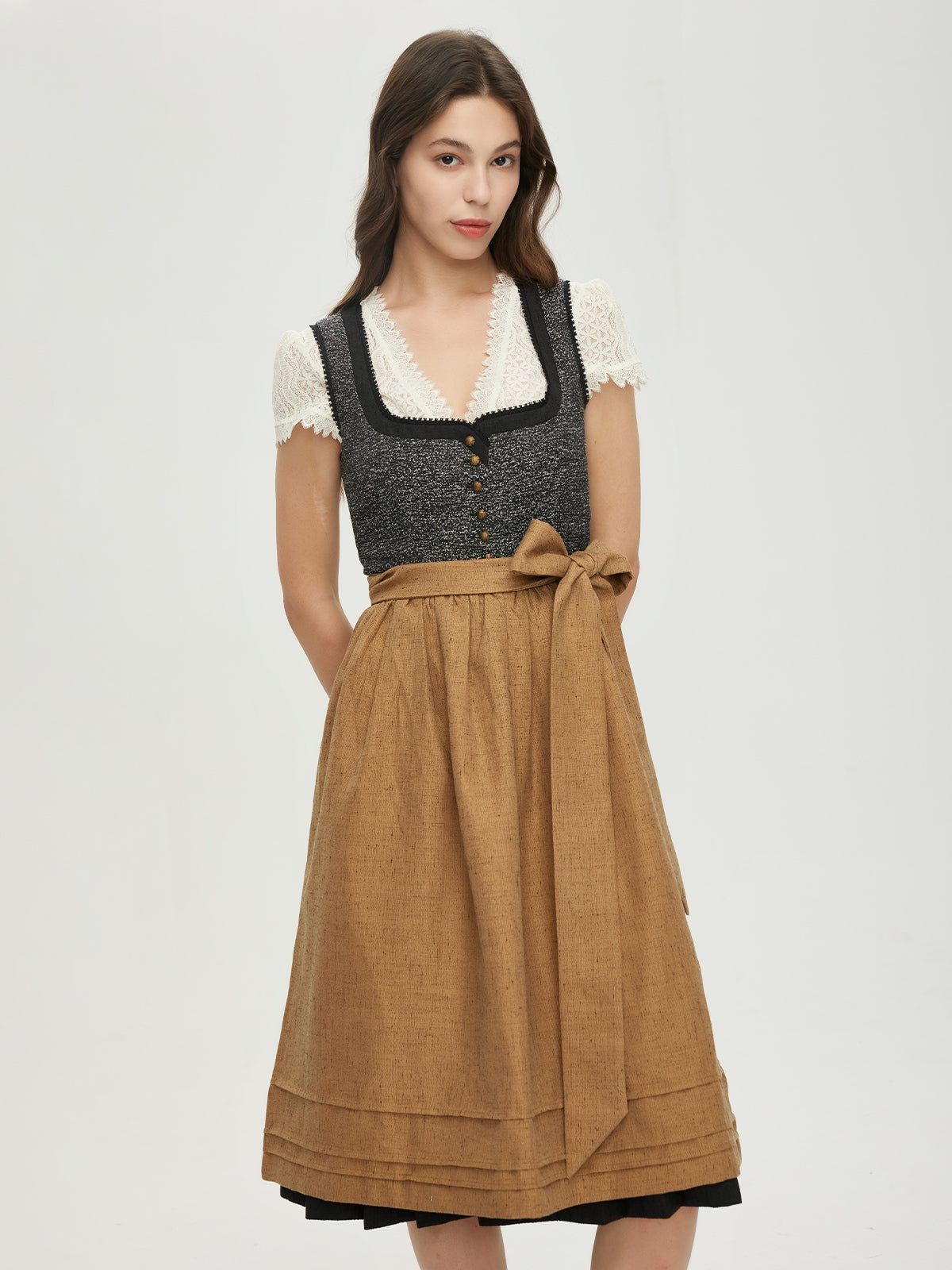Cart
0
The gray dirndl isn't just a piece of clothing—it's a fashion statement. Gray as a color is often underestimated in traditional costume, but its understated elegance makes it an ideal choice for women who want to emphasize their personality in style. Whether it's a simple gray dirndl or a combination like the blue-gray dirndl, gray brings a unique calm and elegance to traditional costumes, perfect for festive occasions like Oktoberfest or weddings.
As Hannah's story progresses, we learn how, through her choice of a gray dirndl, she not only discovers her own style but also gains inner strength. Her inner monologue and the emotional depth inherent in choosing such a dirndl allow readers to reflect on their own fashion choices and perhaps even gain new insights about themselves.
Grey as a fashionable choice: Why a grey dirndl is timeless
Gray may be less striking than bolder colors like red, green, or blue, but it's precisely this understated quality that makes it so special. A gray dirndl exudes elegance and class without being overly overbearing. It's suitable for almost any occasion and can be wonderfully combined with various accessories, giving it a classic yet modern look. For women who don't want to draw attention to themselves but still want to appear stylish, a gray dirndl is the perfect choice.
A blue-gray dirndl adds an extra dimension. The blue brings a cool freshness and stability, while the gray provides understated elegance. This combination is suitable for women who want the best of both worlds: tradition and modern aesthetics. This color choice is ideal for festive occasions where you want to appear neither too conspicuous nor too inconspicuous.
Hannah's renewed reflection: The inner monologue continues
Hannah was still in front of the mirror when memories of past decisions caught up with her again. The insecurity she had initially felt when choosing the gray dirndl began to fade. "Why did I so often feel compelled to wear something that didn't suit me?" she asked herself again, gently running her hand over the fabric.
This dirndl felt right. She had often repeated it to calm herself—the movement of her hands over the fabric, the repeated glances in the mirror. It had become a kind of ritual that helped her gain confidence. "Gray isn't boring," she thought now with conviction. "Gray is exactly what I need—subtle, yet powerful."
Her thoughts kept returning to this truth. She realized that for years she had allowed herself to be guided by the expectations of others. But now, in this moment, she began to accept herself. And the gray dirndl became a symbol of this acceptance.
A recurring thought: The power of repetition
Hannah repeatedly found herself running her fingers over the soft fabric of the gray dirndl. This simple, repeated movement calmed her and reinforced the feeling that she had made the right choice. It was almost like a mantra—a ritual that helped her put aside her insecurities and feel confident in her decision.
This repetition wasn't just a nervous gesture. It was an expression of a deep inner process that led her to greater self-confidence. "I am sure," she repeated quietly, almost unconsciously, as she looked at herself in the mirror again. Choosing the gray dirndl was more than just an aesthetic decision. It was an expression of her inner peace and self-discovery, which empowered her.
A moment of lightness: A relaxed transition
When the day of the celebration finally arrived, Hannah felt surprisingly calm. She had put on the blue-grey dirndl and felt as if a great weight had been lifted from her shoulders. Her initial insecurity had vanished, replaced by a light, free feeling. "It's just a dress," she thought, laughing. "Why did I think about it so much?"
This sudden change in attitude helped her start the day with ease. The decision to wear a gray dirndl had shown her that she didn't always have to conform to other people's expectations. She had found her own style, and it reflected exactly what she truly wanted. Her laughter dissolved the tension she had felt just days before.
An unexpected encounter: support from an unexpected source
When Hannah arrived at the festival, she was greeted by her friends. "Wow, your dirndl looks great!" her friend Lisa exclaimed enthusiastically. Lisa wore a traditional green dirndl, which was beautiful but more striking than the gray dirndl Hannah was wearing. "I never thought gray could look so good!" she added.
Hannah smiled, this time without any hesitation. "Thank you, I thought about it for a long time, but now I'm glad I chose it."
This simple affirmation gave Hannah the final boost of self-confidence she needed. Her decision to choose the blue-gray dirndl was not only the right one, it was also recognized by those around her. It was confirmation that she didn't have to hide, and that her choice to wear a simple yet elegant dirndl was just as impressive as any colorful dress.
The symbolism of the grey dirndl: A sign of self-acceptance
A gray dirndl represents much more than just a color. It's a sign of strength, restraint, and elegance. Women who choose this color often express inner peace and self-acceptance, which is also reflected in their outward appearance. They don't need bright colors to attract attention—their personality speaks for itself.
For Hannah, the blue-gray dirndl was a reflection of her own journey toward greater self-confidence and inner clarity. Through her inner monologue and constant reflection on her decision, she realized that fashion is not just an outward statement, but is also deeply connected to what we feel inside. Choosing a gray dirndl helped her recognize and embrace this inner strength.
Conclusion: The quiet power of a grey dirndl
The gray dirndl and its variations, such as the blue-gray dirndl, offer women a way to express their personality in an elegant yet subtle way. Gray may be a reserved color, but it is precisely this restraint that lends the dress a special elegance and depth. It is a color that is suitable for both festive occasions and everyday wear, and can be perfectly combined.
Hannah's story shows that choosing a dirndl is more than just a fashion choice—it's a journey into oneself, a search for inner clarity and self-acceptance. The gray dirndl symbolizes this journey and shows that sometimes the simplest decisions can have the most profound consequences.
As Hannah's story progresses, we learn how, through her choice of a gray dirndl, she not only discovers her own style but also gains inner strength. Her inner monologue and the emotional depth inherent in choosing such a dirndl allow readers to reflect on their own fashion choices and perhaps even gain new insights about themselves.
Grey as a fashionable choice: Why a grey dirndl is timeless
Gray may be less striking than bolder colors like red, green, or blue, but it's precisely this understated quality that makes it so special. A gray dirndl exudes elegance and class without being overly overbearing. It's suitable for almost any occasion and can be wonderfully combined with various accessories, giving it a classic yet modern look. For women who don't want to draw attention to themselves but still want to appear stylish, a gray dirndl is the perfect choice.
A blue-gray dirndl adds an extra dimension. The blue brings a cool freshness and stability, while the gray provides understated elegance. This combination is suitable for women who want the best of both worlds: tradition and modern aesthetics. This color choice is ideal for festive occasions where you want to appear neither too conspicuous nor too inconspicuous.
Hannah's renewed reflection: The inner monologue continues
Hannah was still in front of the mirror when memories of past decisions caught up with her again. The insecurity she had initially felt when choosing the gray dirndl began to fade. "Why did I so often feel compelled to wear something that didn't suit me?" she asked herself again, gently running her hand over the fabric.
This dirndl felt right. She had often repeated it to calm herself—the movement of her hands over the fabric, the repeated glances in the mirror. It had become a kind of ritual that helped her gain confidence. "Gray isn't boring," she thought now with conviction. "Gray is exactly what I need—subtle, yet powerful."
Her thoughts kept returning to this truth. She realized that for years she had allowed herself to be guided by the expectations of others. But now, in this moment, she began to accept herself. And the gray dirndl became a symbol of this acceptance.
A recurring thought: The power of repetition
Hannah repeatedly found herself running her fingers over the soft fabric of the gray dirndl. This simple, repeated movement calmed her and reinforced the feeling that she had made the right choice. It was almost like a mantra—a ritual that helped her put aside her insecurities and feel confident in her decision.
This repetition wasn't just a nervous gesture. It was an expression of a deep inner process that led her to greater self-confidence. "I am sure," she repeated quietly, almost unconsciously, as she looked at herself in the mirror again. Choosing the gray dirndl was more than just an aesthetic decision. It was an expression of her inner peace and self-discovery, which empowered her.
A moment of lightness: A relaxed transition
When the day of the celebration finally arrived, Hannah felt surprisingly calm. She had put on the blue-grey dirndl and felt as if a great weight had been lifted from her shoulders. Her initial insecurity had vanished, replaced by a light, free feeling. "It's just a dress," she thought, laughing. "Why did I think about it so much?"
This sudden change in attitude helped her start the day with ease. The decision to wear a gray dirndl had shown her that she didn't always have to conform to other people's expectations. She had found her own style, and it reflected exactly what she truly wanted. Her laughter dissolved the tension she had felt just days before.
An unexpected encounter: support from an unexpected source
When Hannah arrived at the festival, she was greeted by her friends. "Wow, your dirndl looks great!" her friend Lisa exclaimed enthusiastically. Lisa wore a traditional green dirndl, which was beautiful but more striking than the gray dirndl Hannah was wearing. "I never thought gray could look so good!" she added.
Hannah smiled, this time without any hesitation. "Thank you, I thought about it for a long time, but now I'm glad I chose it."
This simple affirmation gave Hannah the final boost of self-confidence she needed. Her decision to choose the blue-gray dirndl was not only the right one, it was also recognized by those around her. It was confirmation that she didn't have to hide, and that her choice to wear a simple yet elegant dirndl was just as impressive as any colorful dress.
The symbolism of the grey dirndl: A sign of self-acceptance
A gray dirndl represents much more than just a color. It's a sign of strength, restraint, and elegance. Women who choose this color often express inner peace and self-acceptance, which is also reflected in their outward appearance. They don't need bright colors to attract attention—their personality speaks for itself.
For Hannah, the blue-gray dirndl was a reflection of her own journey toward greater self-confidence and inner clarity. Through her inner monologue and constant reflection on her decision, she realized that fashion is not just an outward statement, but is also deeply connected to what we feel inside. Choosing a gray dirndl helped her recognize and embrace this inner strength.
Conclusion: The quiet power of a grey dirndl
The gray dirndl and its variations, such as the blue-gray dirndl, offer women a way to express their personality in an elegant yet subtle way. Gray may be a reserved color, but it is precisely this restraint that lends the dress a special elegance and depth. It is a color that is suitable for both festive occasions and everyday wear, and can be perfectly combined.
Hannah's story shows that choosing a dirndl is more than just a fashion choice—it's a journey into oneself, a search for inner clarity and self-acceptance. The gray dirndl symbolizes this journey and shows that sometimes the simplest decisions can have the most profound consequences.

